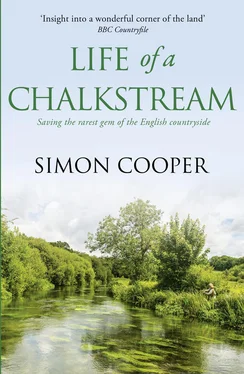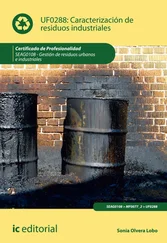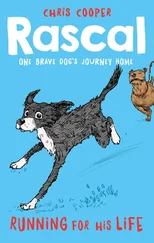On that filthy late October day the success of our survey and the work Steve had done with the digger was there to see. The silt and mud were gone, smeared over the grassland around the hatches. The wet surface of the slabs on the base of the river glinted back at me. Some of them were truly huge; a full 10 feet square and nearly a foot thick. One could only wonder at how they were ever put into position all those centuries ago. The digger stood by ready to drag out the reeds within the hour.
I wasn’t exactly sure where Steve, Dan and the irregulars were working that morning, but the whine of the chainsaw through the rain from somewhere far downstream gave me a rough idea, so I followed the noise. For all our hard work over the past month North Stream really looked in quite a sorry state. I am tempted to say worse than when we had started, but it is always this way, a sort of darkness before the dawn.
The ground along the bank was churned up; deep ruts showed where the tractor had strained and dug deep to pull out the worst of the trees. Every so often I would come across a round circle of ash where the lads had lit fires to burn up the detritus. There was a pile of tree stumps, too big to burn and unwieldy to cut up, so they would be taken away to be dumped and end their lives in a rotting heap. This would be a paradise for woodpeckers seeking easy food and a palatial home for woodlice. From time to time I came across some long, straight tree limbs which had been carefully trimmed and set aside. This was our kind of recycling; logs and branches that would be useful for building weirs, flow deflectors and groynes in the river when we reached the next stage of the restoration.
The entire bank was pockmarked by tree stumps, cut level with the ground: the cream white of the ash; dark red of the alder and burnt orange of the hawthorn. The hazels looked like bundles of cigarette filters pushed into the ground. The fact is we only pulled out the stumps we had to; by far the most were left in the ground. There is no point in ripping them out, as the root structure will live for years and bind the bank together. Some of the stumps will sprout again, indeed species like the alder thrive as a result of the extreme pruning. And as North Stream evolves over the coming years, we’ll let some grow back into mature trees for cover, shade or simply extra interest.
If I thought the banks looked bad, the stream itself looked worse. The water reflected the sky; it was dark and gloomy. Barely flowing, the surface was covered in twigs, chainsaw shavings, dead leaves and chopped vegetation. On the far bank the bushes and trees had shed all their leaves, the spindly branches dripping from the rain. The only comfort I took was in the windbreak they provided from the north wind whipping the rain across the meadows. A north wind is the enemy of all fly-fishers – the cold kills off hatch and stops the fish feeding, which gives rise to that old saw, ‘When the wind is from the north only the foolish angler sets forth.’ However, today was not the day to worry about the north wind, which is an almost daily occurrence in winter, sweeping as it does down the river valley. Days like this are always the fun parts of a restoration, when months of planning and weeks of work come to fruition. Today all we needed to do was dig out the plug of reeds, lift the boards in the Portland hatches and let the river flow in. And that is what we did.
Steve used the digger to scoop out the reeds and we laid them to one side. The flag irises, with their yellow flowers that bloom in May and June, were too beautiful to discard, so we’d replant the rhizome roots down North Stream to kick-start the regrowth in the spring in the parts of the stream left bare by their removal. The reeds gone, the water started to build up against the honey-yellow oak boards. These boards are never completely watertight; water weeps through the gaps between them. So as the flow backed up and the pressure increased, water squirted through the holes as if from a hosepipe. We were ready to open up. Standing on the bridge boards over the hatches we worked in pairs to lift the top boards out. The lower four quickly followed and within moments the fast flow from the Evitt rushed into North Stream. Like excited schoolboys we followed the bulge of water as it forced its way downstream. From time to time it came across an obstruction. Then the water would begin to back up, but when the force grew too strong the obstruction would give way and the flow continued. On it went down North Stream, carrying the mud and debris in its path. Under Bailey Bridge and the final straight to the main river. Standing by the deflector we watched the confluence of the two currents, the first time anyone had seen this for maybe forty or fifty years. True it wasn’t the prettiest of sights, with the dirty water of North Stream adding a nasty stain to the clarity of the Evitt, but the knowledge that our plan had worked was enough for now. Given a few weeks North Stream would flush itself clean, and then the fish would return.
4 CONTENTS Cover Title Page Copyright Dedication To Mary and Nigel. For endless encouragement and always being there. Epigraph For men may come and men may go, But I go on for ever. The Brook by Alfred Lord Tennyson 1 Discovery 2 Decline 3 Work begins 4 Spawning and the cycle of life 5 Scar Boy 6 March 7 How I held a trout for warmth 8 Mayday 9 The mayfly 10 Crayfish invasion 11 Midsummer’s Night 12 High summer 13 The English savanna 14 Cams Point Epilogue Bibliography Acknowledgements About the Publisher
SPAWNING AND THE CYCLE OF LIFE CONTENTS Cover Title Page Copyright Dedication To Mary and Nigel. For endless encouragement and always being there. Epigraph For men may come and men may go, But I go on for ever. The Brook by Alfred Lord Tennyson 1 Discovery 2 Decline 3 Work begins 4 Spawning and the cycle of life 5 Scar Boy 6 March 7 How I held a trout for warmth 8 Mayday 9 The mayfly 10 Crayfish invasion 11 Midsummer’s Night 12 High summer 13 The English savanna 14 Cams Point Epilogue Bibliography Acknowledgements About the Publisher

AFTER THE FRENETIC activity of summer I miss my riverside companions on a winter dawn morning. No reed-chewing water voles suspiciously eyeing my progress along the riverbank, plopping for safety under the water if I come too close. No dew-laden spider webs strung between the purple loosestrife, glinting in the rising sun, as an eager arachnid crabs with intent across the translucent filament harvesting the victims of the night. Even the rabbits have gone, and as for the lolloping hares, no chance of any of those until spring. But even if it is all quiet along the banks, in the ever-clear water of the chalkstream the game is on to create the next generation of trout and salmon.
Trout and salmon are often spoken of in the same breath, but they are in many respects as close to each other in genetic terms as a horse is to a zebra. For a fly-fisherman they define what you are on a river. As salmon and trout are two distinct breeds, so are the men that fish for them. Not to announce which you are, even though you might fish for both, is like saying you support the Manchester football team. United or City? Salmon or trout? Both are equally tribal.
For fish whose subsequent lives will diverge so totally they begin life in the same gravel beds, of the same rivers, at precisely the same time of year. In lives that will span five to seven years some brown trout will travel no more than a few hundred yards from their birthplace, whereas the salmon has a round trip of some 4,000 miles to complete its life cycle. While we may think of a salmon as a river fish, in fact the greatest proportion of its life is spent at sea. These salmon are Atlantic salmon – Salmo salar . Defined as anadromous, their natural habitat is the sea, but they must return to the river of their birth to spawn. The eggs are laid in a river and that first year of life, as they grow from fry to parr and then smolt, is all spent in fresh water. But no chalkstream could ever provide enough food for a salmon to grow to maturity, so at a year old, measuring no more than 6 inches long, they head for the ocean and the food-rich waters off Greenland. It is an epic journey that begins and ends in a stream no more than 15 yards wide and a few feet deep.
Читать дальше













